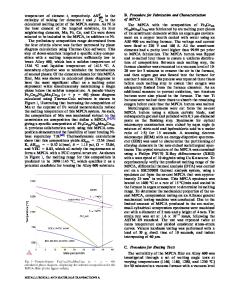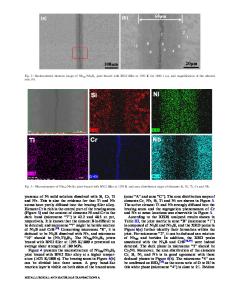Microstructures and mechanical properties of TiAl/Ni-based superalloy joints brazed with Fe-based filler metal
- PDF / 931,150 Bytes
- 7 Pages / 595.276 x 790.866 pts Page_size
- 53 Downloads / 534 Views
RESEARCH PAPER
Microstructures and mechanical properties of TiAl/Ni-based superalloy joints brazed with Fe-based filler metal H. S. Ren 1 & H. P. Xiong 1 & L. Ye 1 & X. Y. Ren 1 & W. W. Li 1 & R. Y. Qin 1 Received: 15 October 2019 / Accepted: 15 September 2020 # International Institute of Welding 2020
Abstract For the purpose of high-temperature service potential and the weight reduction expectation in aviation engineering applications, dissimilar joining of TiAl alloy to Ni-based superalloy has been conducted with a newly designed Fe-based filler metal. The microstructure and chemical composition at the interfaces were investigated by SEM, EPMA, and XRD. The filler metal consisted of Fe-based solid solution and a small amount of precipitated (Fe, Cr)ss. The wettability experiment results showed that the filler metal presented a stronger reaction tendency and more sufficient spreading behavior on Ni-based superalloy than on TiAl alloy. The brazed joint was composed of TiAl diffusion affected zone, Ni3Al, TiCo, borides, (Ni, Fe, Co, Cr)ss, and γ-TiAl dissolved with Ni. A stronger reaction tendency occurred between Ni and TiAl substrate due to the lower dissolution enthalpies of element Ni in melts of Ti and Al. The joints brazed at 1180 °C/5 min presented a shear strength of 267 MPa at room temperature. Keywords TiAl alloy . Ni-based superalloy . Brazing . Microstructure . Mechanical properties
1 Introduction TiAl alloy is a potential structural material for aerospace applications due to its relatively low density, high specific strength, excellent creep behavior, and good oxidation resistance at elevated temperature [1, 2]. Its long-term service temperature can be up to 760~850 °C. Because of its hightemperature service potential as well as the weight reduction effect, TiAl alloy is inclined to be applied as the candidate material for heat-resistance components in advanced aeroengines [3]. At present, Ni-based superalloys are extensively used in aero-engine hot-section components. Hence, the joining between TiAl alloy and Ni-based superalloy to produce dissimilar joints is of great interest to achieve the optimal material combination design.
Recommended for publication by Commission XVII - Brazing, Soldering and Diffusion Bonding * H. S. Ren [email protected] 1
Welding and Plastic Forming Division, Beijing Institute of Aeronautical Materials, Beijing 100095, China
For the joining of TiAl alloy to themselves, methods of fusion welding [4, 5], brazing [6, 7], and diffusion bonding [8, 9] were used. However, the weldability was limited by its poor ductility and damage tolerance at room temperature. It was reported that only small pieces were available for butt joints. This was related not only with its intrinsic brittleness but also with the high residual stress generated by welding thermal cycle [10]. Hence, cracking issue was always encountered when TIG welding, laser welding, and electron beam welding methods were applied. For these welding methods, preheat treatment at the temperature of high up to 800 °C
Data Loading...










